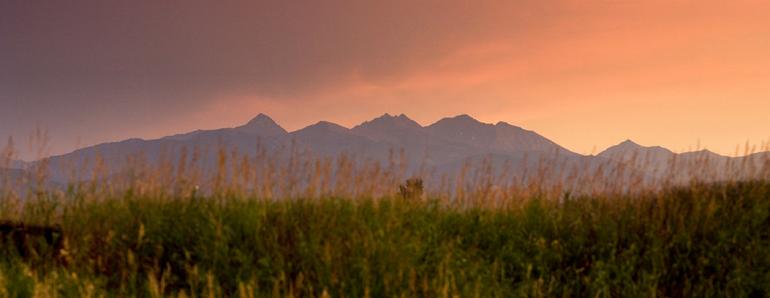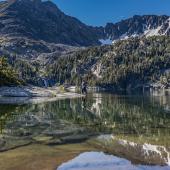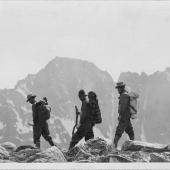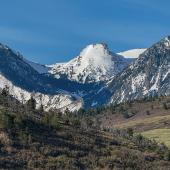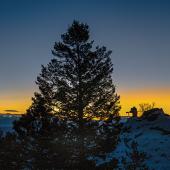Steep, Deep, and Cheap
Twenty-eight road miles (22 miles as a GPS-equipped crow would fly) southwest of the Bozeman city limits, one arrives at the Spanish Creek Guard Station, a major trailhead for the Spanish Peaks Unit of the Lee Metcalf Wilderness Area. Of the many wonderful outdoor attractions surrounding us here in the Gallatin Valley, the "Peaks" are among the most awesome. With their jagged ridgetops angling sharply skyward, casting long shadows on the deep-blue alpine lakes below, these mountains are about as close to heaven as you can get within 30 minutes of downtown Bozeman.
In the 1950s, the gates to the expansive Flying D Ranch, which lies immediately north of the wilderness area, were still largely unlocked. A friend and I roamed the ranch in an old pickup truck on our annual fall hunting "expeditions." This was as close to the mountains themselves as I got during my youth. In general, we were content with admiring the views from a distance. It wasn't until I had moved to the Midwest and subsequently began returning on my family's summer vacations that we ventured into the Peaks themselves.
The Spanish Creek Guard Station is eight miles up Spanish Creek Road from Highway 191 and the Gallatin River. Several trails lead up into the Peaks from the guard station. The alpine lakes of the region tend to serve as destinations in these mountains and the trails, for the most part, take the visitor to and between these lakes. One of the more popular lakes is Mirror Lake, which lies about 7.5 miles from the trailhead with an elevation gain of over 2200 feet. Most of the actual climbing is encountered in a series of rugged switchbacks spread over the last two miles before the lake. As a part of a wilderness area, the Spanish Peaks are closed to motorized vehicles of any kind. Consequently, the only legal modes of entry are pedestrian and equestrian.
Horses tend to bring most folks into these mountains. While some of my best friends are horse people (and riding clubs do a great deal of volunteer trail maintenance), I am mildly biased against horses. We have taken llamas on our trips for over ten years and have convinced ourselves that they are more environmentally friendly than horses. In addition to treading lightly on the trails, llamas are less inclined to consume every blade of grass around the campsites and they leave far less poop on the trails. In any case, llamas have taken a load off of my back and allowed us to move up a notch in the food chain. A thick and juicy filet, grilled rare over an open fire, along with a cerveza chilled in the icy stream running past one's tent, is the ultimate gourmet experience following a trek to 9,000 feet.
The mountains themselves provide good scrambles for climbers. The highest, at a little over 11,000 feet, is Gallatin Peak. This mountain can be climbed in a couple of hours from Thompson Lake, which lies at its western base. Another popular access to Gallatin Peak is from the southeast side by way of the Big Sky area. Blaze Mountain, with the year-round snowbank running down its northwest slope, is another good climb. In my youth, we knew this snowbank by its more colloquial name, Devil's Slide.
One can observe the usual species of alpine wildlife, including deer, elk, and bear, in and around the Peaks. More interesting and at higher elevations are the sheep and goats. With a pair of binoculars or a scope you can easily spot these animals, especially the highly visible white goats, from campsites such as those around Mirror Lake. Limited mountain-goat hunting is occasionally permitted on early-season weekends in September.
There is evidence of earlier human visitors to these mountains in specific localities. For example, obsidian flakes and some complete arrowheads have been discovered. It is apparent that the obsidian is not native to this area and was carried in as a raw material for the arrowheads to be used in hunting. One candidate for these earlier hunters would be the Sheepeater Indians, said to be a reclusive people residing in and around today's Yellowstone National Park.
Most of the lakes in the wilderness area are accessible by fairly well-maintained trails; however, some of my favorites are off the beaten path and fairly remote. Among my top choices in this regard are Diamond Lake, Beehive Lake, and the Chilled Lakes (the latter being a pair of lakes). For me, each of these lakes is rather special in its own way, and each forms a challenging and rewarding destination.
My all-time favorite lake is Diamond Lake, located in a steep, boulder-faced glacial cirque on the north side of the Peaks. There are no trails to Diamond Lake; access requires a good topo map and some fairly strenuous mountainside trekking. I must admit that even my best llama would find the approach difficult. The first view of Diamond Lake can take your breath away – you are not prepared to suddenly come upon a lake of this size in this spectacular setting. The lake even has its own islands. My visits have all been long day trips, as campsites around the lake are virtually nonexistent.
Over twenty years ago, on one of my early trips to Diamond Lake, my brother, my young son, and I got an early start and arrived at the lake around 11:00 a.m. When it was time to head back, my brother, feeling a little adventurous, argued against retracing our steps back to the car. "Why don't we just climb up the back side of the lake," he suggested, "and then go over, around, and back down to the parking lot?" An hour later we were still mid-way up the steep cirque and I remember being desperately afraid that at any moment the three of us would become part of a rockslide tumbling back down toward the lake. Late that afternoon, after several hours of slashing through downed timber, we limped back into the parking lot, too exhausted to worry about dinner.
Beehive Lake is best accessed from the Spanish Lakes area. The trail to this area forks off from the trail to Mirror Lake and skirts the lower west side of Blaze Mountain. The Spanish Lakes, a group of four alpine lakes at over 8,800 feet, are themselves a worthy destination. Set just below the divide looking over into the Big Sky area, the landscape is dotted with huge boulders and small groves of stunted alpine fir – individual trees huddled together in a struggle to survive in this severe environment. Beehive Lake, above and to the east of the Spanish Lakes and directly south of Blaze Mountain, is reached by scrambling up a steep, shale-strewn couloir. Beehive's setting, at over 9,600 feet, is dramatic in its raw, elemental harshness. Don't plan on camping here; the cirque enclosing Beehive Lake is devoid of campsites and vegetation.
While I have never had any luck fishing in the lakes of the wilderness area, one of my nephews caught a few trout in Beehive Lake several years ago. I assume these fish were planted (probably from the air) at some public expense. In view of the long portion of the year that the lake's surface is frozen, it's hard to imagine any significant survival rate, to say nothing of reproduction.
Directly west of Gallatin Peak, and clearly visible from its upper reaches, are the Chilled Lakes. This pair of lakes is readily accessible from the trail past Thompson Lake and the subsequent hike is a relatively short trek across tundra-like vegetation. Even though the Chilled Lakes are as high as Beehive Lake, the setting here is almost pastoral with grassy surroundings and the brilliant blue sky reflected in the water on a calm day. When my brother and I topped the last rise before the lakes on a recent visit, a band of 15-20 sheep, including several lambs, ambled slowly away along the far shores of the lakes.
There are other remote lakes in the Spanish Peaks. The three I've just mentioned each involve a challenging access and each has its own distinctive character. They are there for the enjoyment of the visitor and we can be grateful to those legislators who had the foresight to set this region apart as an official wilderness area. The mountains are steep, the lakes are deep, and a weekend trek into the area, including high-end gear from the shops of Bozeman, will set one back far less than a holiday to Puerto Vallarta. In fact, the balance would easily cover the cost of a good pack llama.
These shining mountains on the south end of the Gallatin Valley form a kind of visual magnet for residents of the area. Exploring the peaks on foot has only increased their attraction for me. I am sometimes reminded of the lines from Matthew Arnold's poem, "The Buried Life":
And then he thinks he knows
The hills where his life rose...

